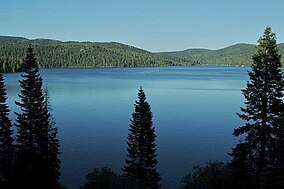Plumas National Forest
| Plumas National Forest | |
|---|---|
IUCN category VI (protected area with sustainable use of natural resources) | |
 Bucks Lake in Plumas National Forest | |
Map of California | |
| Nearest city | Quincy, California |
| Coordinates | 40°00′01″N 120°40′05″W / 40.00028°N 120.66806°W |
| Area | 1.1 million acres |
| Established | 1907 |
| Governing body | U.S. Forest Service |
| Website | Plumas National Forest |
Plumas National Forest is a 1,146,000-acre (4,638 km2) United States National Forest located in the Sierra Nevada, in northern California.
Geography
About 85% of Plumas National Forest lies in Plumas County, but smaller portions are found in eastern Butte, northern Sierra, southern Lassen, and northeastern Yuba counties. [1] The Plumas National Forest Supervisor's office is located in Quincy, California. There are local ranger district offices in Blairsden, Oroville, and Quincy.[1]
History
Plumas was established as the Plumas Forest Reserve by the General Land Office on March 27, 1905. In 1906 the forest was transferred to the U.S. Forest Service, and on March 4, 1907 it became a National Forest. On July 1, 1908 a portion of Diamond Mountain National Forest was added.[2] The Bucks Lake Wilderness was officially designated in 1984 as a part of the National Wilderness Preservation System.
Ecology
A 2002 study by the Forest Service identified 127,000 acres (51,000 ha) of the forest as old growth.[3] The most common old-growth forest types are:
- mixed conifer forests of:
- Coast Douglas-fir (Pseudotsuga menziesii var. menziesii)
- Ponderosa Pine (Pinus ponderosa)
- White Fir (Abies concolor)
- and
- Jeffrey Pine (Pinus jeffreyi) forests
- Red Fir (Abies magnifica) forests
See also
References
- ^ USFS Ranger Districts by State
- ^ Davis, Richard C. (September 29, 2005), National Forests of the United States (pdf), The Forest History Society
- ^ Warbington, Ralph; Beardsley, Debby (2002), 2002 Estimates of Old Growth Forests on the 18 National Forests of the Pacific Southwest Region, United States Forest Service, Pacific Southwest Region
External links
- IUCN Category VI
- Plumas National Forest
- Protected areas of the Sierra Nevada (U.S.)
- Protected areas of Plumas County, California
- Protected areas of Butte County, California
- Protected areas of Sierra County, California
- Protected areas of Lassen County, California
- Protected areas of Yuba County, California
- Feather River
- National Forests of California
- Protected areas established in 1905
- 1905 establishments in California


